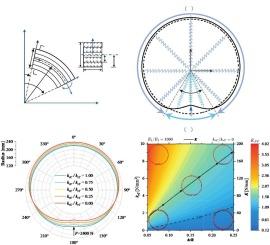Analytical modeling of laminated composite rings on nonreciprocal elastic foundations under non-axisymmetric loading
IF 3.8
3区 工程技术
Q1 MECHANICS
International Journal of Solids and Structures
Pub Date : 2025-09-17
DOI:10.1016/j.ijsolstr.2025.113665
引用次数: 0
Abstract
A mechanical model of a laminated composite ring on a nonreciprocal elastic foundation is a valuable engineering tool during the early design stages of various applications, such as non-pneumatic wheels, flexible bearings/bushings, expandable tubulars in oil wells, and vascular stents interacting with blood vessel linings, especially under non-axisymmetric loadings. Despite its importance, limited research has focused on the interaction between laminated composite rings and nonreciprocal elastic foundations. Moreover, no quantitative studies have yet explored the influence of foundation stiffness on the ring’s deformation. This work aims to develop an analytical framework for a laminated composite ring supported by a nonreciprocal elastic foundation under non-axisymmetric loading conditions. The model generates a design map that correlates the foundation’s stiffness with the ring’s deformation, accounting for ring dimensions, laminate lay-up architecture, and lamina anisotropy. The closed-form solution provides an efficient design tool for analyzing non-axisymmetric and nonuniform loadings at a low computational cost. The resulting design map provides a valuable resource for exploring the interaction between the nonreciprocal foundation and the laminated ring. The proposed analytical framework and design map hold broad potential applications in automotive, mechanical, civil, and biomedical engineering fields.

非轴对称荷载作用下非互易弹性地基层合复合材料环的解析建模
非互易弹性基础上的层压复合环的力学模型在各种应用的早期设计阶段是一个有价值的工程工具,例如非气动车轮,柔性轴承/衬套,油井中的可膨胀管,血管支架与血管衬里相互作用,特别是在非轴对称载荷下。尽管其重要性,有限的研究集中在层压复合材料环与非互易弹性基础之间的相互作用。此外,尚未有定量研究探讨基础刚度对环变形的影响。本工作旨在建立非轴对称载荷条件下非互易弹性基础支撑的层压复合材料环的分析框架。该模型生成一个设计地图,将基础的刚度与环的变形联系起来,考虑到环的尺寸、层压叠加结构和层的各向异性。闭式解以较低的计算成本为分析非轴对称和非均匀载荷提供了一种有效的设计工具。由此产生的设计图为探索非互易基础与层压环之间的相互作用提供了宝贵的资源。提出的分析框架和设计图在汽车、机械、土木和生物医学工程领域具有广泛的应用潜力。
本文章由计算机程序翻译,如有差异,请以英文原文为准。
求助全文
约1分钟内获得全文
求助全文
来源期刊
CiteScore
6.70
自引率
8.30%
发文量
405
审稿时长
70 days
期刊介绍:
The International Journal of Solids and Structures has as its objective the publication and dissemination of original research in Mechanics of Solids and Structures as a field of Applied Science and Engineering. It fosters thus the exchange of ideas among workers in different parts of the world and also among workers who emphasize different aspects of the foundations and applications of the field.
Standing as it does at the cross-roads of Materials Science, Life Sciences, Mathematics, Physics and Engineering Design, the Mechanics of Solids and Structures is experiencing considerable growth as a result of recent technological advances. The Journal, by providing an international medium of communication, is encouraging this growth and is encompassing all aspects of the field from the more classical problems of structural analysis to mechanics of solids continually interacting with other media and including fracture, flow, wave propagation, heat transfer, thermal effects in solids, optimum design methods, model analysis, structural topology and numerical techniques. Interest extends to both inorganic and organic solids and structures.

 求助内容:
求助内容: 应助结果提醒方式:
应助结果提醒方式:


